Abstract
Monoclonal antibodies of the OKT series were used to identify circulating T lymphocytes (OKT3+), their helper-inducer (OKT4+) and suppressor-cytotoxic (OKT8+) subsets and cells bearing Ia antigen (OKIa+) in 75 patients with thyroid autoimmune disorders, including 14 Graves' disease, 21 myxoedema, 20 asymptomatic thyroiditis, 12 Hashimoto's thyroiditis and eight simple goitre with superimposed thyroiditis. In the whole population of patients, a negative correlation was observed between the percentage of OKT8+ cells and serum free thyroxine levels whatever the type of thyroiditis. The percentage of OKT8+ cells was decreased in Graves' disease and increased in myxoedema while it reversed after adequate treatment of the two diseases. However, a trend to a decrease in the proportion of OKT8+ cells was still observed in treated Graves' disease and in all the other groups of thyroiditis with euthyroidism. The minor modifications observed for OKT3+ and OKT4+ cells were in relation with those of OKT8+ cells. There was an increased percentage of Ia+ cells in Graves' disease and in Hashimoto's thyroiditis partly reflecting the presence of activated lymphocytes. In conclusion, these data suggest first of all a direct influence of serum T4 on the distribution of circulating OKT8+ cells in addition to documenting the heterogeneity of T cell immunoregulatory factors.
Full text
PDF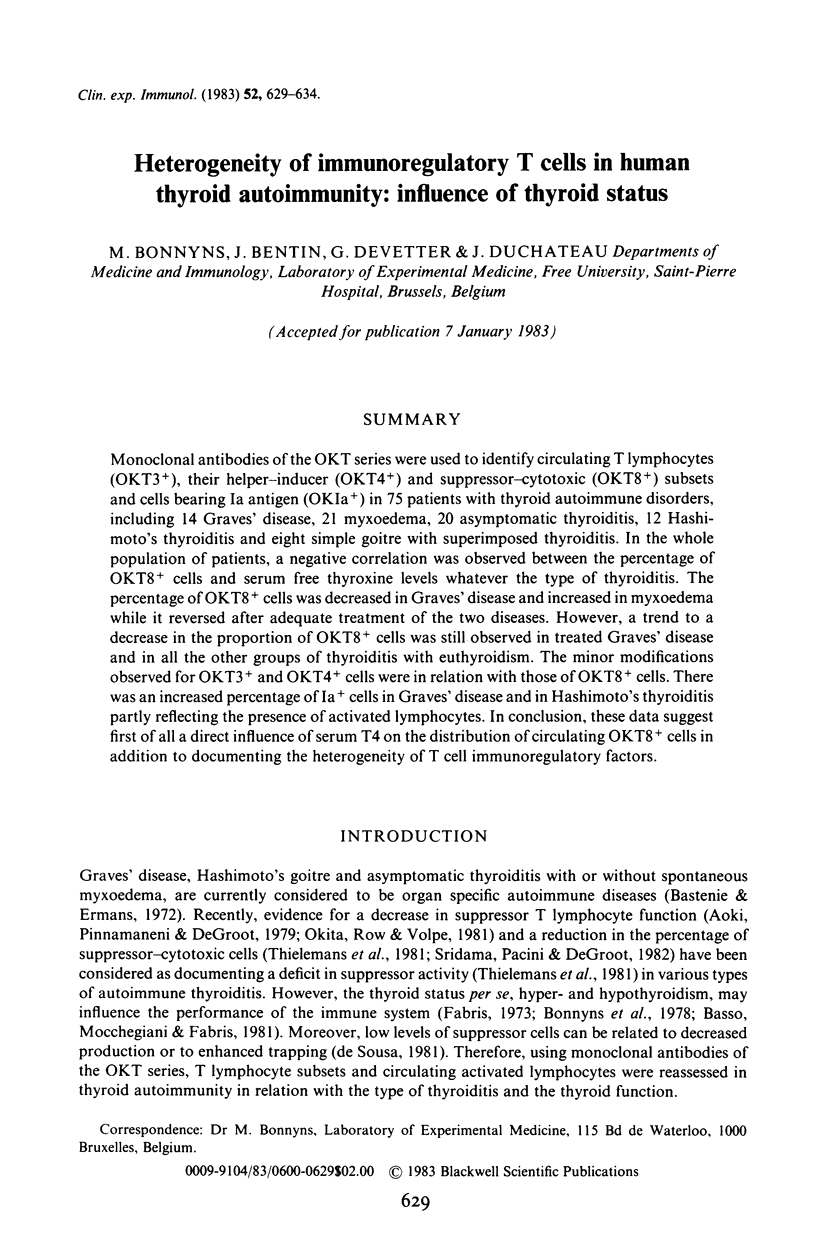
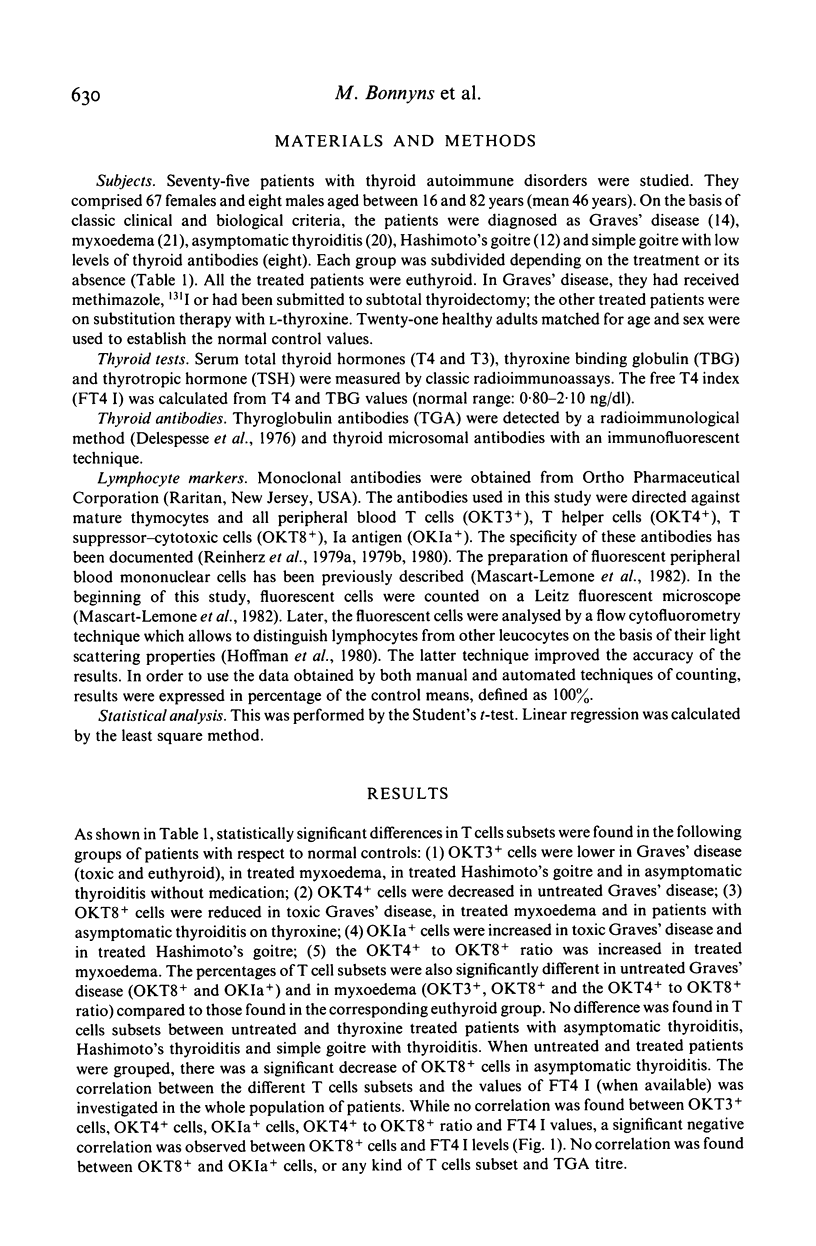
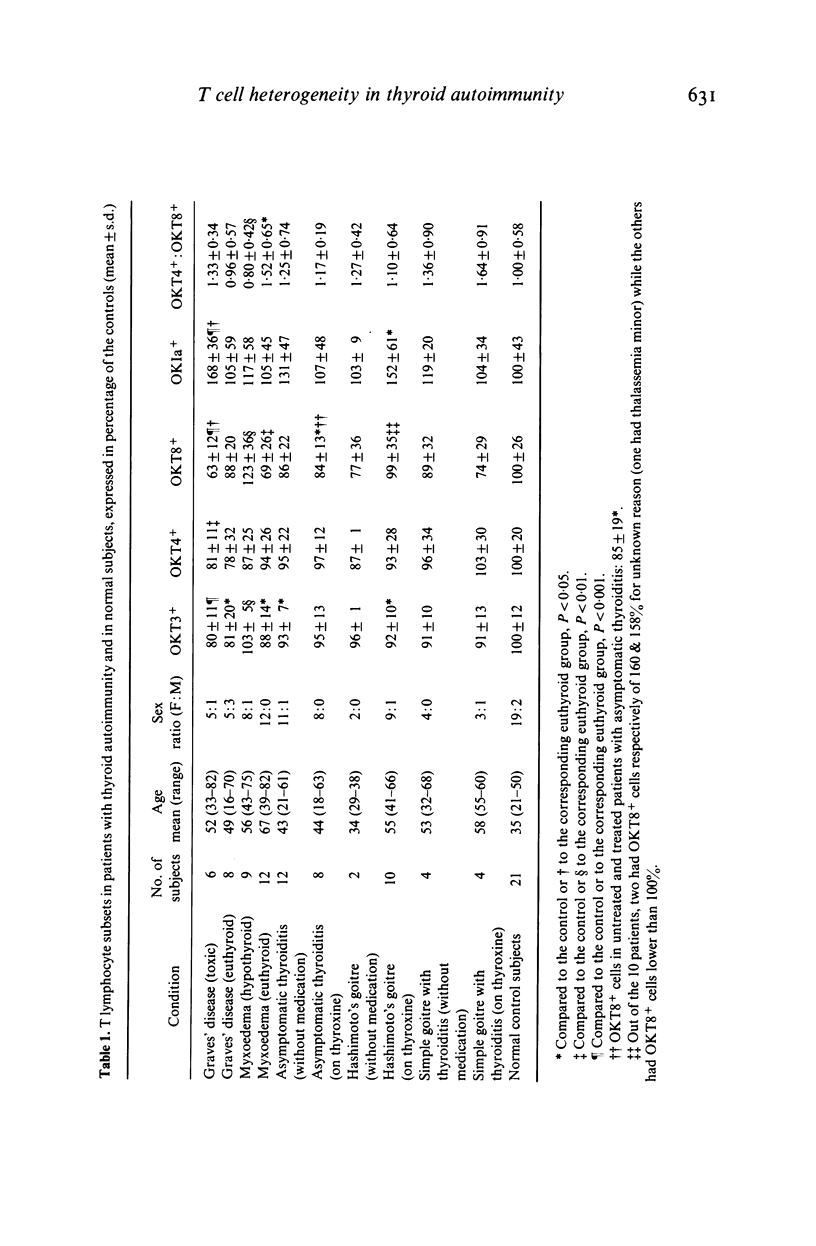
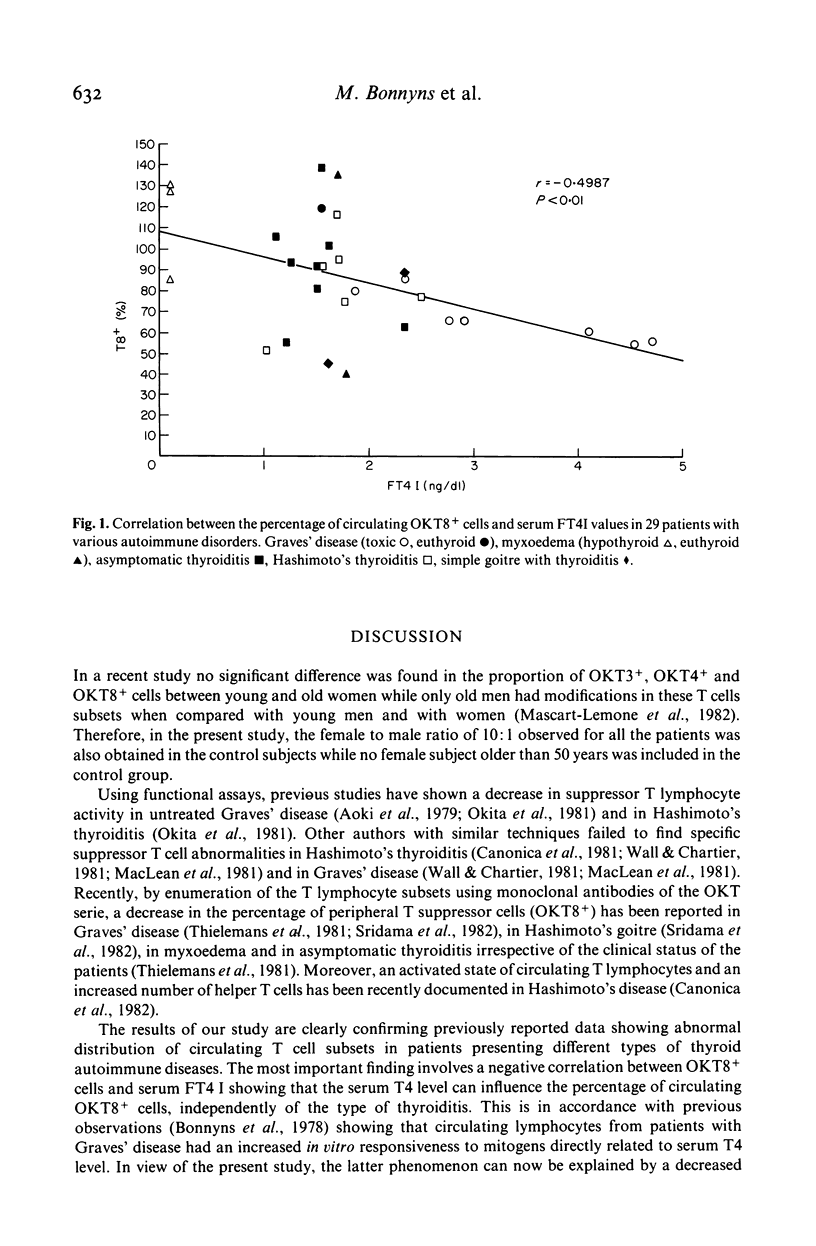
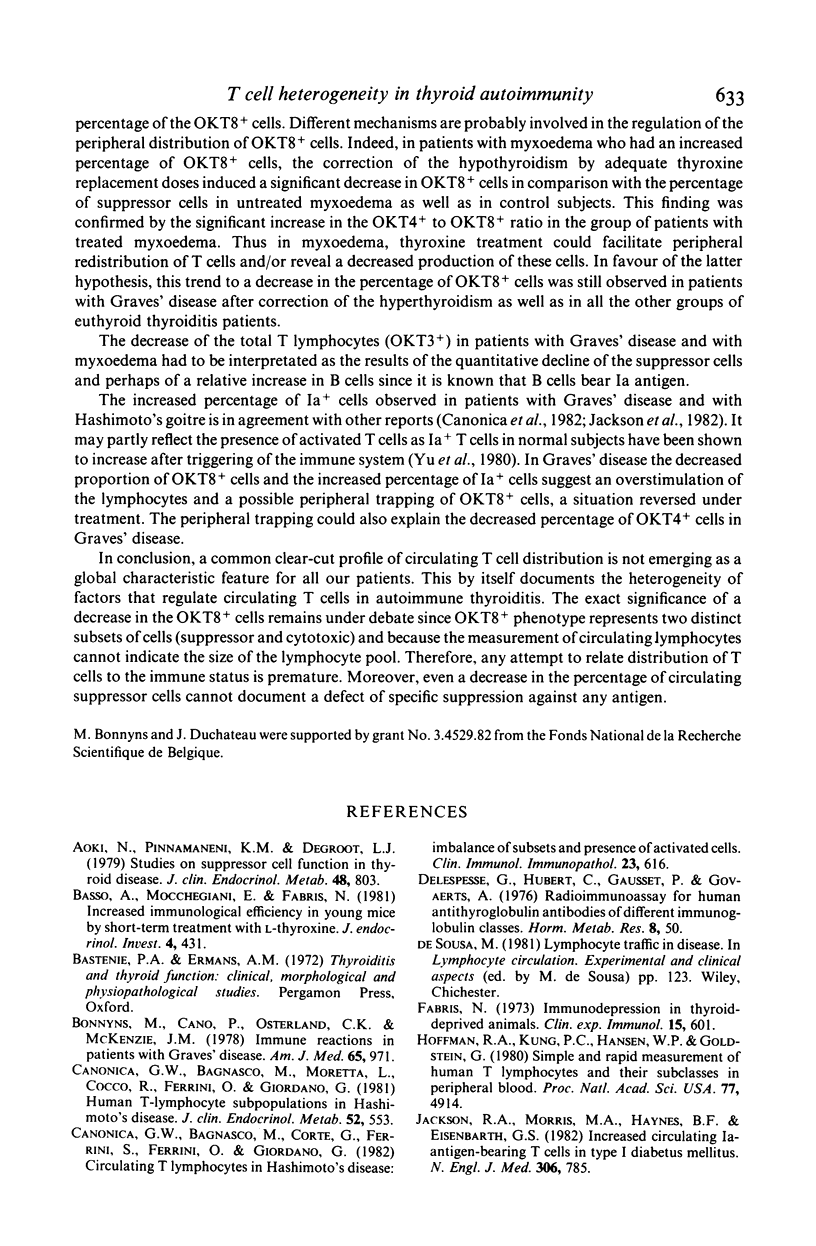
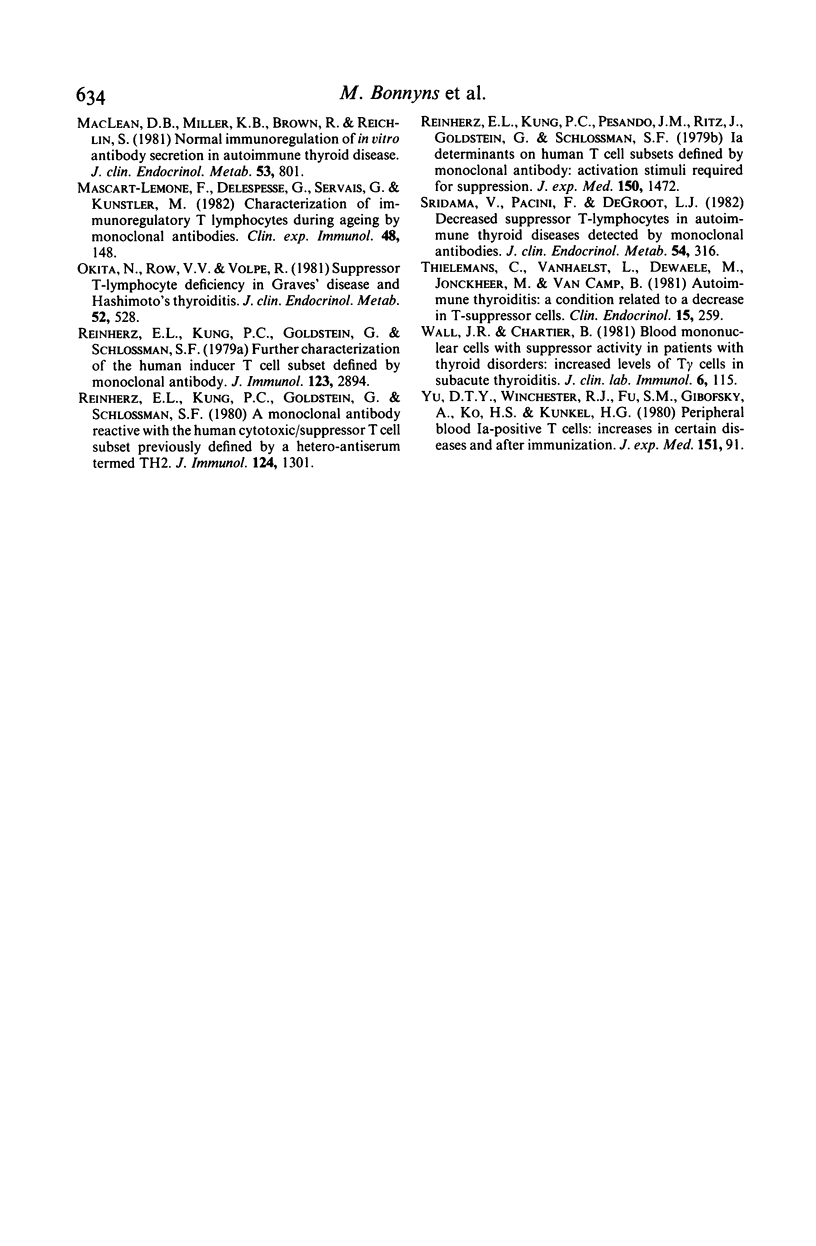
Selected References
These references are in PubMed. This may not be the complete list of references from this article.
- Aoki N., Pinnamaneni K. M., DeGroot L. J. Studies on suppressor cell function in thyroid diseases. J Clin Endocrinol Metab. 1979 May;48(5):803–810. doi: 10.1210/jcem-48-5-803. [DOI] [PubMed] [Google Scholar]
- Basso A., Mocchegiani E., Fabris N. Increased immunological efficiency in young mice by short-term treatment with L-thyroxine. J Endocrinol Invest. 1981 Oct-Dec;4(4):431–438. doi: 10.1007/BF03348307. [DOI] [PubMed] [Google Scholar]
- Bonnyns M., Cano P., Osterland C. K., McKenzie J. M. Immune reactions in patients with Graves' disease. Am J Med. 1978 Dec;65(6):971–977. doi: 10.1016/0002-9343(78)90749-0. [DOI] [PubMed] [Google Scholar]
- Canonica G. W., Bagnasco M., Corte G., Ferrini S., Ferrini O., Giordano G. Circulating T lymphocytes in Hashimoto's disease: imbalance of subsets and presence of activated cells. Clin Immunol Immunopathol. 1982 Jun;23(3):616–625. doi: 10.1016/0090-1229(82)90324-5. [DOI] [PubMed] [Google Scholar]
- Canonica G. W., Bagnasco M., Moretta L., Cocco R., Ferrini O., Giordano G. Human T-lymphocyte subpopulations in Hashimoto's disease. J Clin Endocrinol Metab. 1981 Mar;52(3):553–556. doi: 10.1210/jcem-52-3-553. [DOI] [PubMed] [Google Scholar]
- Delespesse G., Hubert C., Gausset P., Govaerts A. Radioimmunoassay for human antithyroglobulin antibodies of different immunoglobulin classes. Horm Metab Res. 1976 Jan;8(1):50–54. doi: 10.1055/s-0028-1093692. [DOI] [PubMed] [Google Scholar]
- Fabris N. Immunodepression in thyroid-deprived animals. Clin Exp Immunol. 1973 Dec;15(4):601–611. [PMC free article] [PubMed] [Google Scholar]
- Hoffman R. A., Kung P. C., Hansen W. P., Goldstein G. Simple and rapid measurement of human T lymphocytes and their subclasses in peripheral blood. Proc Natl Acad Sci U S A. 1980 Aug;77(8):4914–4917. doi: 10.1073/pnas.77.8.4914. [DOI] [PMC free article] [PubMed] [Google Scholar]
- Jackson R. A., Morris M. A., Haynes B. F., Eisenbarth G. S. Increased circulating Ia-antigen-bearing T cells in type I diabetes mellitus. N Engl J Med. 1982 Apr 1;306(13):785–788. doi: 10.1056/NEJM198204013061305. [DOI] [PubMed] [Google Scholar]
- MacLean D. B., Miller K. B., Brown R., Reichlin S. Normal immunoregulation of in vitro antibody secretion in autoimmune thyroid disease. J Clin Endocrinol Metab. 1981 Oct;53(4):801–805. doi: 10.1210/jcem-53-4-801. [DOI] [PubMed] [Google Scholar]
- Mascart-Lemone F., Delespesse G., Servais G., Kunstler M. Characterization of immunoregulatory T lymphocytes during ageing by monoclonal antibodies. Clin Exp Immunol. 1982 Apr;48(1):148–154. [PMC free article] [PubMed] [Google Scholar]
- Okita N., Row V. V., Volpe R. Suppressor T-lymphocyte deficiency in Graves' disease and Hashimoto's thyroiditis. J Clin Endocrinol Metab. 1981 Mar;52(3):528–533. doi: 10.1210/jcem-52-3-528. [DOI] [PubMed] [Google Scholar]
- Reinherz E. L., Kung P. C., Goldstein G., Schlossman S. F. A monoclonal antibody reactive with the human cytotoxic/suppressor T cell subset previously defined by a heteroantiserum termed TH2. J Immunol. 1980 Mar;124(3):1301–1307. [PubMed] [Google Scholar]
- Reinherz E. L., Kung P. C., Pesando J. M., Ritz J., Goldstein G., Schlossman S. F. Ia determinants on human T-cell subsets defined by monoclonal antibody. Activation stimuli required for expression. J Exp Med. 1979 Dec 1;150(6):1472–1482. doi: 10.1084/jem.150.6.1472. [DOI] [PMC free article] [PubMed] [Google Scholar]
- Sridama V., Pacini F., DeGroot L. J. Decreased suppressor T-lymphocytes in autoimmune thyroid diseases detected by monoclonal antibodies. J Clin Endocrinol Metab. 1982 Feb;54(2):316–319. doi: 10.1210/jcem-54-2-316. [DOI] [PubMed] [Google Scholar]
- Thielemans C., Vanhaelst L., de Waele M., Jonckheer M., Van Camp B. Autoimmune thyroiditis: a condition related to a decrease in T-suppressor cells. Clin Endocrinol (Oxf) 1981 Sep;15(3):259–263. doi: 10.1111/j.1365-2265.1981.tb00664.x. [DOI] [PubMed] [Google Scholar]
- Wall J. R., Chartier B. Blood mononuclear cells with suppressor activity in patients with thyroid disorders: increased levels of T gamma cells in subacute thyroiditis. J Clin Lab Immunol. 1981 Sep;6(2):115–119. [PubMed] [Google Scholar]
- Yu D. T., Winchester R. J., Fu S. M., Gibofsky A., Ko H. S., Kunkel H. G. Peripheral blood Ia-positive T cells. Increases in certain diseases and after immunization. J Exp Med. 1980 Jan 1;151(1):91–100. doi: 10.1084/jem.151.1.91. [DOI] [PMC free article] [PubMed] [Google Scholar]


